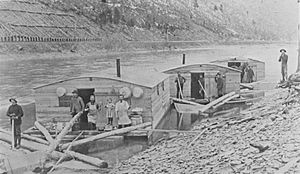Ark (river boat) facts for kids

Three Arks for a log drive on Pine Creek in Lycoming County or Tioga County. The left ark was for cooking and dining, the middle ark was the sleeping quarters, and the right ark was for the draft horses.
• The arks were built for just one trip down river and then dismantled and sold for their lumber. The line of the Jersey Shore, Pine Creek and Buffalo Railway can be seen on the eastern shore, and the mountainside behind it is nearly bare of trees from clear-cutting. |
|
Quick facts for kids Class overview |
|
|---|---|
| General characteristics |
An ark was a special kind of temporary boat used in eastern North America a long time ago. These boats were important for moving goods on rivers. They were used before canals (waterways with locks to control water levels) and railroads became common. Arks were simple to build using basic tools.
They were mainly used to carry cargo downriver during the spring freshets. A freshet is a sudden rise in a river's water level, often from melting snow or heavy rain. Arks carried things like cut lumber, charcoal, and farm products to cities or ports. Sometimes, when logs were floated downriver in rafts, arks would go along to provide living space for the crew.
Contents
Why Arks Were So Important
Arks played a big role in moving goods, especially during the early Industrial Revolution. This was a time when new machines and factories changed how things were made.
Carrying Coal to Cities
Arks were used most often to carry anthracite coal. This was a new, important fuel needed by industries in eastern cities. In 1816, Josiah White invented the Bear Trap Lock system. This invention allowed people to create controlled "freshets" on the Lehigh Canal.
This made it possible to ship large amounts of coal. For about ten years, more and more arks were built. They traveled about 105 miles (169 km) to docks in Philadelphia, carrying this valuable new fuel.
Building Many Arks
By 1831, the Lehigh Coal & Navigation Company was cutting down huge amounts of trees to build arks. They needed to ship enough coal to meet the high demand in Philadelphia. A historian named Fred Brenckman noted that if all the arks built by the company in 1831 were linked together, they would stretch for over 13 miles (21 km)!
- The boats used on the Lehigh River were like square boxes.
- They were about 16 to 18 feet wide and 25 feet long.
- At first, two of these sections were joined together.
- Later, more sections were added, making the boats up to 180 feet long.
- They were steered with long oars, like a raft.
When an ark reached its destination, its cargo was sold. Then, the ark itself was taken apart, and its lumber was sold too. The ark pilots would then walk or ride horses back home.
Even though arks were slow, they were stable. A skilled crew could steer them through narrow parts of the river. Other smaller boats, like the bateau, often traveled with the arks. These smaller boats ferried workers, while the larger arks carried horses, beds, and supplies.
Ark Sizes and Features
Some arks in the Pennsylvania Canal System and Susquehanna River system were up to 75 feet (23 m) long. On the Lehigh Canal, modular ark trains could be coupled together to be as long as 220 feet (67 m). However, these very long arks could only go through the descending locks half at a time.
Arks on the Greenbrier River in West Virginia were usually about sixty feet long. Larger cooking arks were used to feed loggers four times a day. These river arks were a common sight during spring floods. They carried white pine logs from Pocahontas County to Greenbrier County.
Inside an Ark
The author W. E. Blackhurst described a river ark in his book Riders of the Flood:
- The ark was built on a solid platform of logs, 60 feet long and 24 feet wide.
- Strong lash poles were placed across the logs every four feet.
- A low building was built on top of the raft, with a plank floor.
- The building was a simple rectangular hut made of sawed lumber.
- The roof was rounded, made by bending roof boards.
- There was open space at each end of the raft and narrow pathways along the sides of the building.
- Sturdy posts made of apple wood were at each corner. These were used for tying up the ark. Apple wood was chosen because it wouldn't get rough from the ropes rubbing against it.
Steering the Ark
The steering system was interesting:
- At each end of the log platform, there was a short log base with a strong wooden pin sticking up.
- This pin acted as a pivot point for a long steering sweep.
- The sweep was a long, tapered pole, about 20 feet long.
- A broad wooden blade, nearly 10 feet long, was attached to the water end of the sweep.
- It took the strength of two men at each sweep handle to swing the heavy sweep and guide the ark.
The small building on the ark was divided into three parts. At each end were two stalls for horses. The middle section was for carrying horse feed, harnesses, and tools. It also served as the sleeping area for the teamsters (people who drove the horses).
Arks in Culture and History
Today, the town of Ronceverte, West Virginia, hosts a play called Riders of the Flood every September. It is based on the book of the same name. A smaller model of a river ark is part of the set, showing how accurate the play is to history.
The village of Arkport, New York got its name from these special river boats.
See Also
tr:Kano

